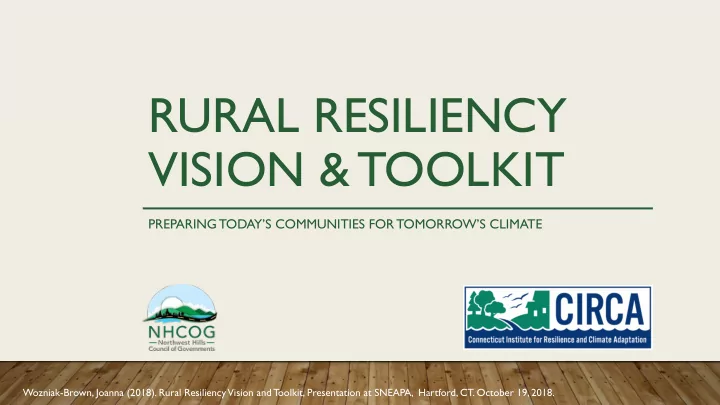

RURAL RESILIENCY VISION & TOOLKIT PREPARING TODAY’S COMMUNITIES FOR TOMORROW’S CLIMATE Wozniak-Brown, Joanna (2018). Rural Resiliency Vision and Toolkit, Presentation at SNEAPA, Hartford, CT. October 19, 2018.
Northwest Hills Council of Governments Joanna Wozniak-Brown, PhD, Regional Planner Wozniak-Brown, Joanna (2018). Rural Resiliency Vision and Toolkit, Presentation at SNEAPA, Hartford, CT. October 19, 2018.
WHAT IS RESILIENCE? “The amount of change the system can undergo and still retain the same controls on function and structure…[and] the community's ability to build and increase its capacity for learning and adaptation.” Resilience Alliance. (2010). Assessing resilience in social-ecological systems: Workbook for practitioners Version 2.0. Retrieved from http://www.resalliance.org/3871.php Wozniak-Brown, Joanna (2018). Rural Resiliency Vision and Toolkit, Presentation at SNEAPA, Hartford, CT. October 19, 2018.
Agriculture CLIMATE CHANGE = “WICKED PROBLEM” Natural Infrastructure Resources Cultural Public Health Resources Wozniak-Brown, Joanna (2018). Rural Resiliency Vision and Toolkit, Presentation at SNEAPA, Hartford, CT. October 19, 2018.
“Rural America’s importance to the country’s economic and social well-being is disproportionate to its population, as rural areas provide natural resources that much of the rest of the United States depends on for food, energy, water, forests, recreation, national character, and quality of life. Rural economic foundations and community cohesion are intricately linked to these natural systems, which are inherently vulnerable to climate change.” Hales, D., Hohenstein, W., Bidwell, M. D., Landry, C., McGranahan, D., Molnar, J., … Jadin, J. (2014). Ch. 14: Rural Communities. Climate Change Impacts in the United States: The Third National Climate Assessment. https://doi.org/10.7930/J01Z429C Wozniak-Brown, Joanna (2018). Rural Resiliency Vision and Toolkit, Presentation at SNEAPA, Hartford, CT. October 19, 2018.
RURAL AREAS ARE ESPECIALLY VULNERABLE • Dependency on natural resources for agriculture, recreation, ecosystem services, and quality of life • Geographic isolation, limited economic diversity, aging population, etc. • Limited transportation, infrastructure, and health/emergency networks National Climate Assessment, 2014, Fig 5.6 Wozniak-Brown, Joanna (2018). Rural Resiliency Vision and Toolkit, Presentation at SNEAPA, Hartford, CT. October 19, 2018.
RURAL AREAS HAVE SOME ADVANTAGES • Active volunteer base • Traditions of self-reliance and neighborliness • Have skilled natural resource knowledge • Inventive and resourceful community decision- makers • Inter-municipal partnership & planning Litchfield Courthouse, photo by Joanna Wozniak-Brown Wozniak-Brown, Joanna (2018). Rural Resiliency Vision and Toolkit, Presentation at SNEAPA, Hartford, CT. October 19, 2018.
Why are COGs important for resiliency? • All adaptation is local • Local governments make infrastructure, development, emergency management decisions. • Requires coordination with multiple state and federal agencies • Crosses funding, technical expertise, and municipal boundaries • Regional regional identity and overlapping vulnerabilities Wozniak-Brown, Joanna (2018). Rural Resiliency Vision and Toolkit, Presentation at SNEAPA, Hartford, CT. October 19, 2018.
PROJECT NEED • Most climate change adaptation guidance focuses on urban/coastal communities and/or sector-specific issues • Integrate resiliency into long-term regional planning • Maximize Return on Investment from other projects • Streamline environmental and emergency planning • Bridge gap between immediate response and long range resiliency Wozniak-Brown, Joanna (2018). Rural Resiliency Vision and Toolkit, Presentation at SNEAPA, Hartford, CT. October 19, 2018.
RURAL RESILIENCY VISION Wozniak-Brown, Joanna (2018). Rural Resiliency Vision and Toolkit, Presentation at SNEAPA, Hartford, CT. October 19, 2018.
RURAL RESILIENCY TOOLKIT Review of POCDs, NHMPs, state/federal climate documents Paper report and a “living website” Menu of adaptations 10 case studies of adaptations for vulnerabilities from similar regions Recommendations for next CT Climate Preparedness Plan Wozniak-Brown, Joanna (2018). Rural Resiliency Vision and Toolkit, Presentation at SNEAPA, Hartford, CT. October 19, 2018.
TOOLKIT STRENGTHS Adaptation Menu will be reviewed by Planner Suggested strategies will be municipal-scale Coordinate with Sustainable CT program Suggest partners for resiliency projects Improve equity and coverage of next CT Climate Preparedness Plan Wozniak-Brown, Joanna (2018). Rural Resiliency Vision and Toolkit, Presentation at SNEAPA, Hartford, CT. October 19, 2018.
Joanna Wozniak-Brown, PhD, Regional Planner Northwest Hills Council of Governments Jbrown@northwesthillscog.org 860-491-9884 Special Thanks to CIRCA! Wozniak-Brown, Joanna (2018). Rural Resiliency Vision and Toolkit, Presentation at SNEAPA, Hartford, CT. October 19, 2018.
Recommend
More recommend